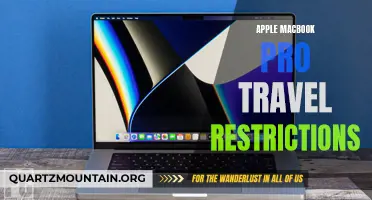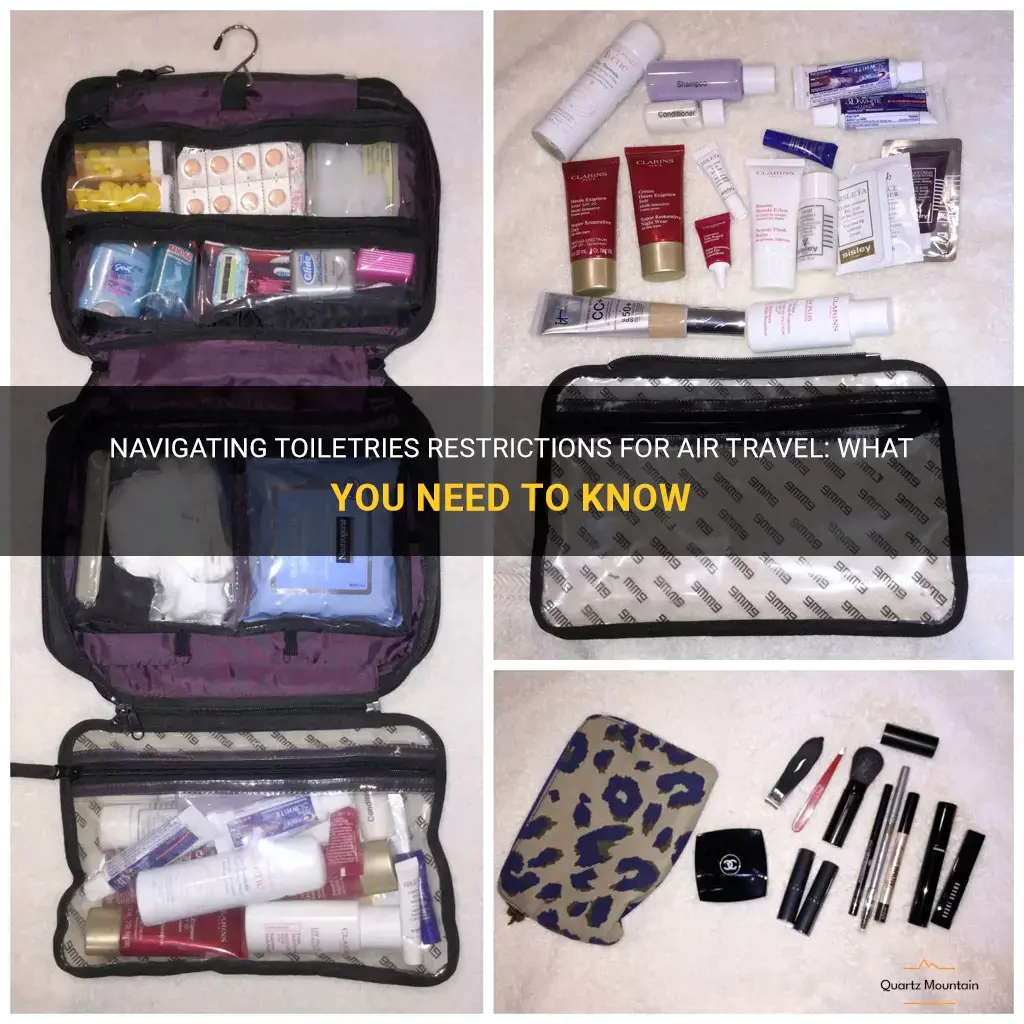
Air travel has become an essential mode of transportation for many people around the world. Whether it's for business or pleasure, hopping on a plane allows us to travel incredible distances in a short amount of time. However, with the convenience of air travel comes certain restrictions, particularly when it comes to what we can and cannot bring with us in our carry-on luggage. One area that often causes confusion and frustration is toiletries restrictions. From the size of bottles to the types of products allowed, navigating these restrictions can feel like a puzzle. In this article, we will explore the ins and outs of toiletries restrictions for air travel, so you can pack your bags with ease and confidence for your next trip.
| Characteristics | Values |
|---|---|
| Liquid Restrictions | Maximum 3.4 ounces or 100 milliliters |
| Bag Size Restrictions | Maximum 1 quart (1 liter) |
| Container Type Restrictions | Must be in a clear, zip-top plastic bag |
| Number of Bags Allowed | 1 bag per passenger |
| Specific Items Not Allowed | Sharp objects, flammable liquids, gels, etc |
| Medications and Baby Formula Allowance | Exempted from the liquids limit |
| Screening Process | Separate screening in a clear, plastic bag |
| Throwing Away Liquids | Available liquid items can be discarded |
| Duty-Free Liquids Allowance | Possible exemption with proof of purchase |
What You'll Learn
- What are the current toiletries restrictions for air travel?
- Can I bring travel-sized toiletries on an airplane?
- Are there specific limits on the amount of liquid toiletries I can bring on a plane?
- What types of toiletries are not allowed in carry-on luggage?
- Are there any exceptions or special considerations for toiletries restrictions when traveling with children?

What are the current toiletries restrictions for air travel?
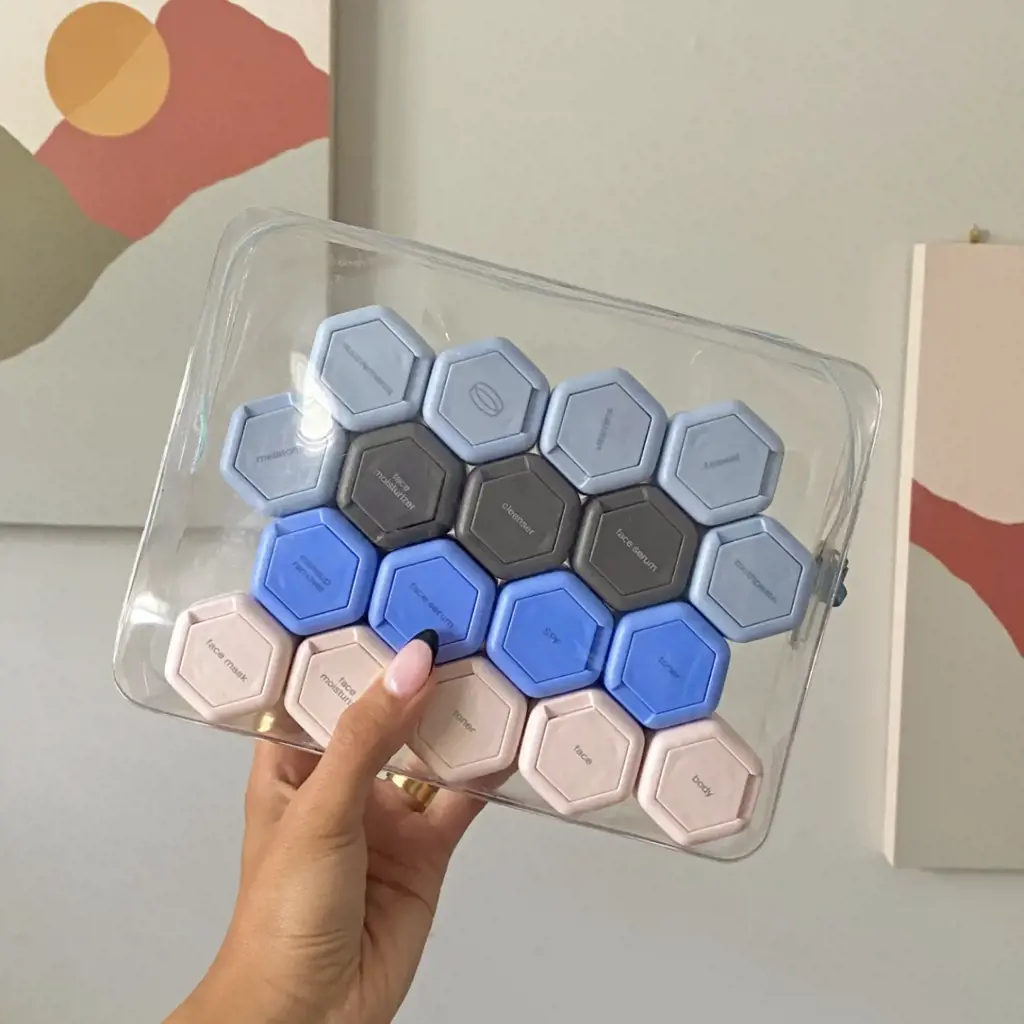
When it comes to air travel, there are certain restrictions in place regarding the toiletries you can bring on board. These restrictions are in place for the safety and security of all passengers and crew members.
One of the main restrictions for toiletries is the maximum size of containers. In general, all liquids, gels, and aerosols must be in containers that are 3.4 ounces (100 milliliters) or less. These containers must be placed in a single, clear, quart-sized bag. Each passenger is limited to one quart-sized bag of liquids.
Additionally, there are restrictions on the types of toiletries you can bring. For example, sharp objects such as razors or nail clippers are generally not allowed in your carry-on luggage. Instead, these items should be packed in your checked baggage. Other restricted items include flammable or explosive materials, such as lighter fluid or fireworks.
It's important to note that these restrictions apply to both carry-on and checked baggage. This means that even if you're planning to pack your toiletries in your checked luggage, they still need to comply with the size and type limitations.
If you're unsure about whether a certain item is allowed on the plane or not, it's always best to check with the airline or transportation security administration (TSA) before your flight. They will have the most up-to-date information on current restrictions and can provide guidance on what is allowed.
To ensure a smooth and efficient security screening process, it's recommended to pack your toiletries in an easily accessible and separate bag. This way, you can quickly remove and place the bag in a screening bin when going through security checkpoints.
While it may seem inconvenient to have to comply with these toiletries restrictions, they are in place to prioritize the safety and security of all passengers. By following these guidelines, you can help ensure a safe and efficient travel experience for everyone.
In conclusion, the current toiletries restrictions for air travel include limitations on the size of containers and restrictions on certain types of items. It's important to familiarize yourself with these restrictions and pack your toiletries accordingly. By doing so, you can help promote a safe and secure travel environment.
Navigating the Current Montana Travel Restrictions: What You Need to Know
You may want to see also

Can I bring travel-sized toiletries on an airplane?
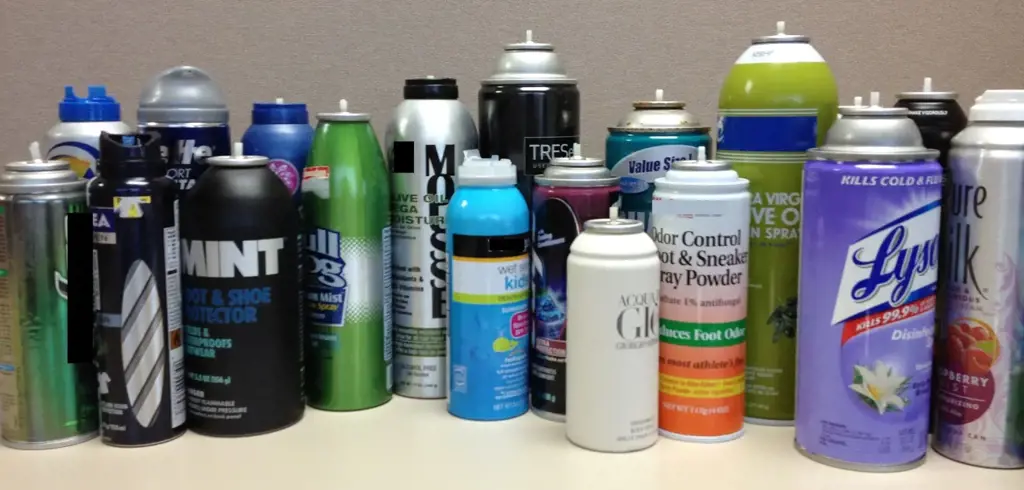
When it comes to packing for air travel, there are strict regulations regarding the size and content of toiletries that you can bring on board. Generally, passengers are allowed to bring travel-sized toiletries on an airplane, as long as they adhere to the guidelines set by the Transportation Security Administration (TSA).
The TSA allows passengers to bring a quart-sized bag of liquids, aerosols, gels, creams, and pastes in their carry-on luggage. Each individual container must not exceed 3.4 ounces or 100 milliliters in volume. It is important to note that the 3.4-ounce limit applies to the container size and not the actual amount of product inside the container. Therefore, even if you have a half-empty 6-ounce container, you will not be able to bring it on board.
To ensure compliance with these regulations, it is recommended to purchase travel-sized toiletries that are specifically labeled as 3.4 ounces or less. These mini-sized containers are widely available at drugstores, supermarkets, and travel specialty stores. Alternatively, you can transfer your favorite toiletries into smaller travel-sized bottles that meet the 3.4-ounce requirement. Be sure to check the volume markings on the bottles to guarantee that they comply with the TSA regulations.
When packing your toiletries, it is essential to place them in a clear, resealable plastic bag. The TSA requires all liquids to be placed in a quart-sized bag that can be easily viewed during the security screening process. This means that all toiletries must fit comfortably in a clear bag that can be sealed. By placing your travel-sized toiletries in a clear bag, you are ensuring that they can easily be inspected by the TSA.
During the security screening process, you will be asked to remove the quart-sized bag containing your travel-sized toiletries from your carry-on luggage and place it in a separate bin. This allows the TSA officers to conduct a thorough inspection of the liquids and prevent any potential security threats. By following this procedure, you can help expedite the screening process and avoid any unnecessary delays.
It is worth mentioning that certain toiletries, such as medications and infant formula, may be exempt from the 3.4-ounce limit and the bag requirement. However, it is advisable to check with the specific airline or the TSA website for the most up-to-date regulations regarding these exemptions.
In conclusion, you are allowed to bring travel-sized toiletries on an airplane as long as they meet the requirements set by the TSA. Make sure your toiletries are contained in 3.4-ounce or less containers and placed in a clear, resealable plastic bag. By following these guidelines, you can ensure a smooth and hassle-free security screening process.
Understanding the Travel Restrictions in Oregon Lockdown: What You Need to Know
You may want to see also

Are there specific limits on the amount of liquid toiletries I can bring on a plane?
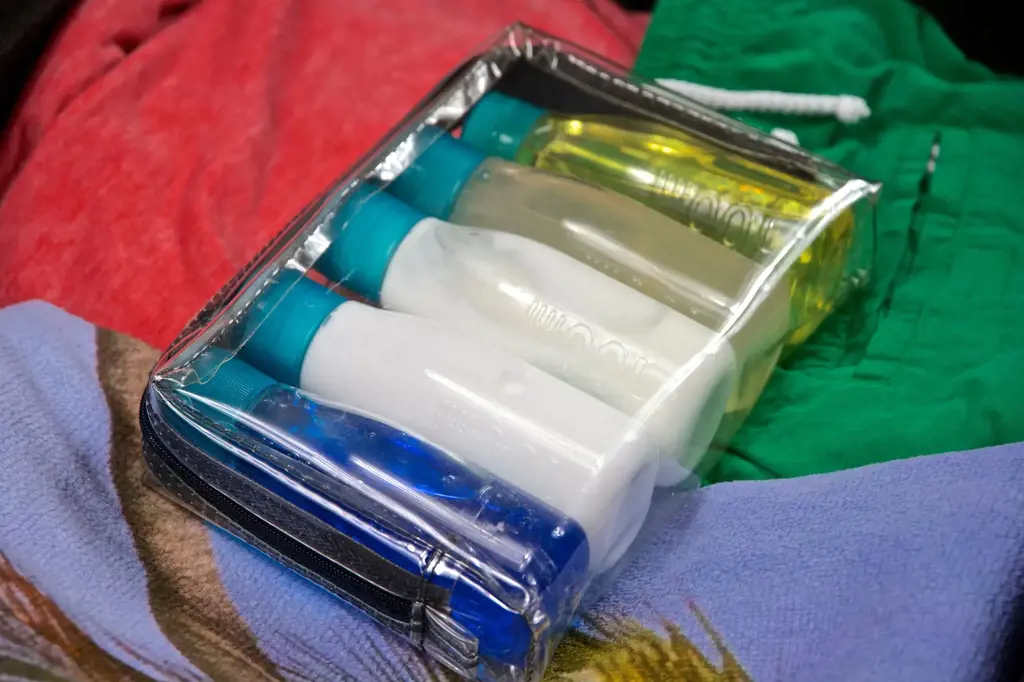
When it comes to packing for a trip, there are often many rules and regulations to consider, especially when it comes to what you can bring on a plane. One common question travelers may have is whether there are specific limits on the amount of liquid toiletries they can bring with them.
The short answer is yes, there are restrictions on the amount of liquid toiletries you can bring on a plane. These restrictions are in place for security reasons and are enforced by the Transportation Security Administration (TSA). Failure to comply with these restrictions could result in your toiletries being confiscated or even being denied entry onto the plane.
The specific limit on the amount of liquid toiletries you can bring is known as the 3-1-1 rule. This rule allows passengers to bring small containers of liquid toiletries in their carry-on luggage, as long as they meet certain requirements. The "3" in the 3-1-1 rule refers to the maximum size of each container, which must be 3.4 ounces (100 milliliters) or less. The "1" refers to the maximum number of containers you can bring, which must fit into a single quart-sized clear plastic bag. And the "1" at the end refers to the fact that each passenger is limited to one quart-sized bag of liquid toiletries.
It's important to note that the 3-1-1 rule applies to all types of liquid toiletries, including items such as shampoo, conditioner, toothpaste, and deodorant. It also applies to other liquids, gels, and aerosols, such as perfume, hair spray, and lotion. If you have any containers larger than 3.4 ounces, they will need to be placed in your checked luggage.
To adhere to the 3-1-1 rule, follow these steps:
- Gather the liquid toiletries you plan to bring with you on your trip.
- Check the size of each container to ensure it is 3.4 ounces or less.
- Place the containers into a quart-sized clear plastic bag. Make sure the bag is completely sealed and can be easily opened for inspection.
- Remember that you are limited to one quart-sized bag per passenger.
- Keep your quart-sized bag of liquid toiletries easily accessible, as you will be required to remove it from your carry-on luggage during the security screening process.
It's also worth noting that certain exceptions to the 3-1-1 rule apply for certain medical or dietary needs. For example, if you need to bring larger quantities of liquid medications, baby formula, or breast milk, these items are allowed in larger quantities as long as you declare them at the security checkpoint and they are properly screened.
In conclusion, there are specific limits on the amount of liquid toiletries you can bring on a plane. The 3-1-1 rule allows for small containers of liquid toiletries, as long as they are 3.4 ounces or less, fit into a quart-sized clear plastic bag, and each passenger is limited to one quart-sized bag. By following these guidelines, you can ensure a smooth and hassle-free journey through airport security.
Navy Personnel Face Travel Restrictions in Peru Amidst Pandemic
You may want to see also

What types of toiletries are not allowed in carry-on luggage?
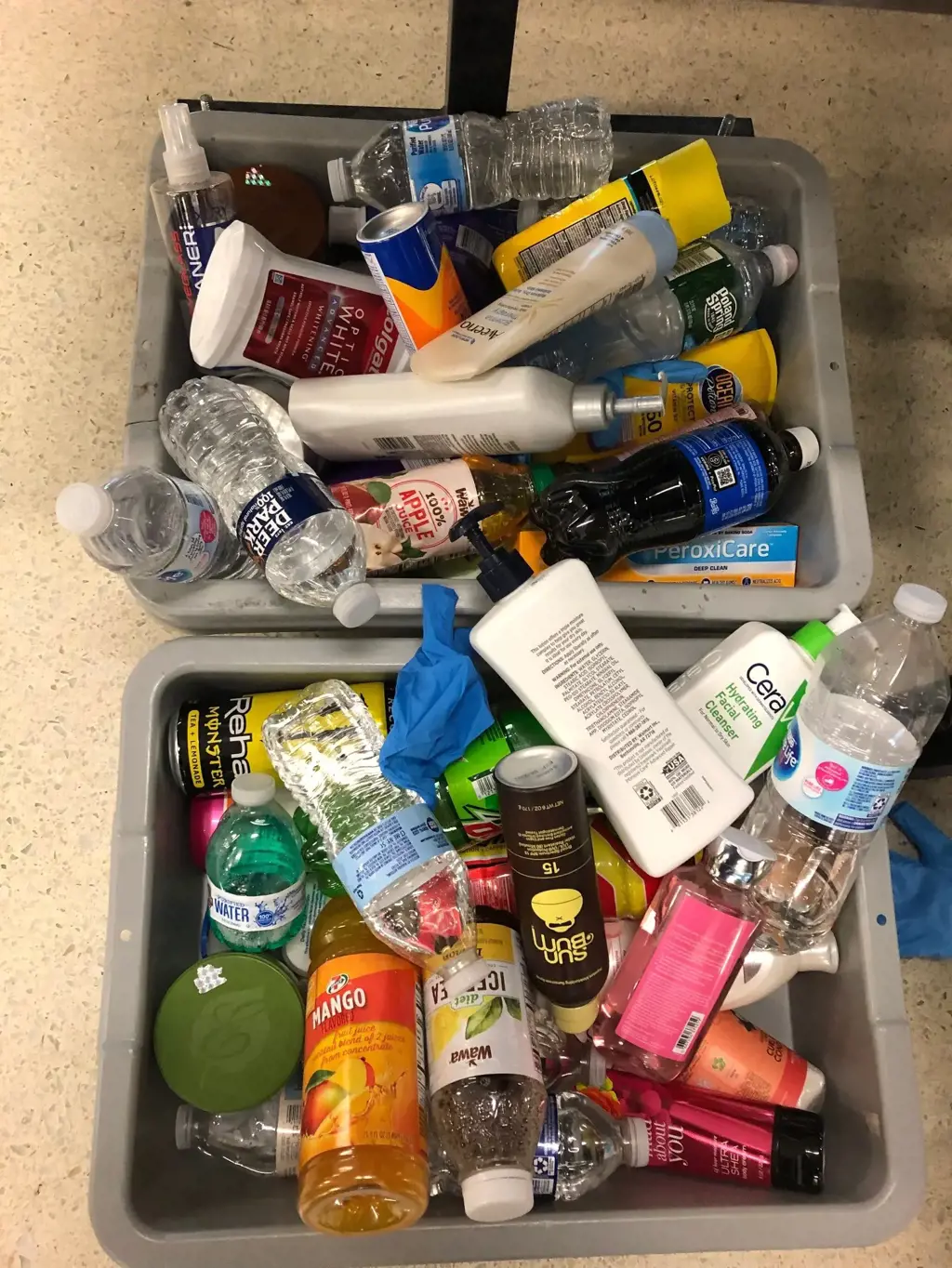
When it comes to packing for a trip, it's important to know what items are allowed and not allowed in your carry-on luggage. This includes toiletries, which can vary in terms of restrictions depending on the mode of transportation and security regulations in place. In this article, we will be discussing the types of toiletries that are not allowed in carry-on luggage.
Safety is the main concern of airlines and transportation authorities when it comes to carrying certain toiletries on board. The following types of toiletries are generally not allowed in carry-on luggage:
- Liquids over 3.4 ounces (100 milliliters): The restrictions regarding liquids in carry-on luggage are known as the 3-1-1 rule. This means each passenger is allowed to carry a quart-sized bag containing liquids, aerosols, gels, creams, and pastes that are each in containers of 3.4 ounces (100 milliliters) or less. Any liquids exceeding this limit should be packed in checked luggage.
- Flammable or explosive toiletries: Items such as hairspray, perfume, nail polish remover, and lighter fluid are considered flammable and are prohibited in carry-on luggage due to safety reasons. These items contain chemicals that could potentially ignite or explode under certain conditions, posing a significant risk during flight.
- Sharp or pointed toiletries: Objects like razors, scissors, or nail clippers with pointed blades or edges may be confiscated if found in carry-on luggage. These items are considered potential weapons and are prohibited to ensure passenger safety.
- Sporting equipment with toiletries: Certain sporting equipment that contains toiletries may not be allowed in carry-on luggage. For example, a can of sunscreen packed inside a tennis racket or a water bottle filled with shampoo inside a yoga mat might be considered as violating the rules against carrying liquids, even if the total volume does not exceed the limit.
- Oversized toiletries: Toiletries such as large bottles of shampoo, conditioner, or lotion that exceed the carry-on limit should be packed in checked luggage. These oversized toiletries may not fit in the quart-sized bag required for carry-on liquids, and their size may also be a potential safety concern.
It is important to note that these restrictions may vary slightly depending on the airline or country you are flying with. Therefore, it is always best to check the specific regulations of your airline or consult the Transportation Security Administration (TSA) guidelines before packing your carry-on luggage.
In conclusion, understanding what types of toiletries are not allowed in carry-on luggage is crucial to ensure a smooth and hassle-free trip. By adhering to the 3-1-1 rule and being aware of the items mentioned above, you can avoid delays at security checkpoints and ensure the safety of yourself and fellow passengers. Remember to pack any prohibited toiletries in your checked luggage or find alternative options that comply with the regulations in place.
Spain Considering Reviewing Travel Restrictions as COVID-19 Situation Improves
You may want to see also

Are there any exceptions or special considerations for toiletries restrictions when traveling with children?
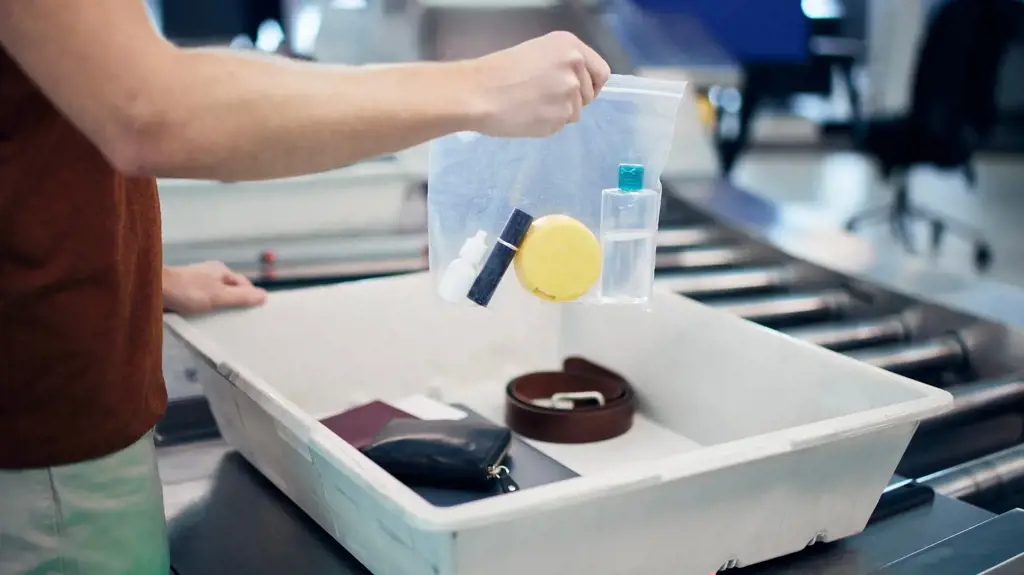
When traveling with children, there are several exceptions and special considerations for toiletries restrictions that parents should be aware of. While most of the rules and regulations regarding toiletries apply to all travelers, there are a few additional factors to keep in mind when traveling with little ones.
One of the main exceptions when it comes to toiletries for children is the allowance of larger quantities of certain items. For example, baby formula, breast milk, and juice for infants and toddlers are generally exempt from the restrictions on liquids. The Transportation Security Administration (TSA) allows parents to carry these items in quantities greater than 3.4 ounces (100 milliliters) in their carry-on bags. However, it is important to note that these items may be subject to additional screening.
Additionally, parents are allowed to bring disposable diapers, wipes, and creams in their carry-on bags without any size restrictions. This is particularly important for long flights or trips where access to these items may be limited. It is a good idea to pack enough for the duration of the journey, as well as a few extras in case of unexpected delays or emergencies.
When it comes to medications for children, parents are also given some leeway in terms of the quantity and size of containers. Prescription medications, including liquid medications, are allowed in quantities greater than 3.4 ounces (100 milliliters). It is advisable to carry a doctor's note or prescription for these medications to avoid any potential issues at security checkpoints.
In terms of special considerations, parents should be aware of any specific allergy concerns or sensitivities their child may have. It is important to check the ingredients of any toiletries or personal care products being used on or by the child to ensure they are suitable and safe. This is especially true for children with eczema or sensitive skin, as certain products may exacerbate their condition.
Parents should also consider the practicality of toiletries when traveling with children. Travel-sized containers of shampoo, conditioner, and body wash may not be sufficient for an extended trip, particularly if multiple children are involved. In these cases, it may be more convenient to purchase full-sized toiletries at the destination or to pack larger containers in checked luggage.
It is worth noting that the rules and regulations regarding toiletries restrictions may vary slightly depending on the country or airline. It is always a good idea to check with the specific airline and consult official travel advisories for the most up-to-date information.
In conclusion, when traveling with children, there are exceptions and special considerations for toiletries restrictions. Parents are allowed to bring larger quantities of baby formula, breast milk, and juice for infants and toddlers. Disposable diapers, wipes, and creams are also exempt from size restrictions. Prescription medications for children are allowed in larger quantities, but it is advisable to carry a doctor's note or prescription. It is important to check the ingredients of toiletries for any allergy concerns or sensitivities. Parents should also consider the practicality of toiletries and may need to pack larger containers or purchase full-sized products at the destination. Always check with the specific airline and consult official travel advisories for the most accurate information.
Understanding Denmark's Travel Restrictions: What You Need to Know
You may want to see also
Frequently asked questions
Yes, you are allowed to bring toiletries in your carry-on bag when traveling by air. However, there are restrictions on the size and quantity of these items. Each liquid or gel product must be in a container that is 3.4 ounces (100 milliliters) or less, and all of the containers must fit into a clear, one quart-sized plastic bag.
You are allowed to bring as many containers of toiletries as you can fit into a one quart-sized plastic bag. However, each container must be 3.4 ounces (100 milliliters) or less in size. If you have larger containers, they will need to be packed in your checked luggage.
Yes, you are allowed to bring a razor in your carry-on bag when traveling by air. However, it must be a safety razor or disposable razor with a blade cartridge. Straight razors or razor blades that are not secured in a cartridge are not allowed in carry-on bags and must be packed in checked luggage.
There are no restrictions on the size or quantity of liquids or gels in your checked luggage. However, it is always a good idea to pack these items in a leak-proof bag or container to prevent any spills or damage to other items in your luggage.
Yes, you are allowed to bring aerosol toiletries in your carry-on bag when traveling by air. However, there are some additional restrictions. Each aerosol container must be 3.4 ounces (100 milliliters) or less in size and must be placed in a clear, one quart-sized plastic bag. Additionally, there is a limit of one bag per passenger.







